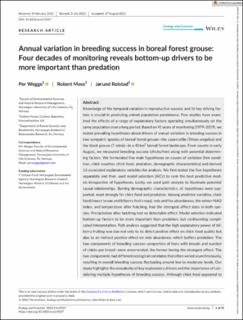| dc.description.abstract | Knowledge of the temporal variation in reproductive success and its key driving factors is crucial in predicting animal population persistence. Few studies have examined the effects of a range of explanatory factors operating simultaneously on the same population over a long period. Based on 41 years of monitoring (1979–2019), we tested prevailing hypotheses about drivers of annual variation in breeding success in two sympatric species of boreal forest grouse—the capercaillie (Tetrao urogallus) and the black grouse (T. tetrix)—in a 45 km2 boreal forest landscape. From counts in early August, we measured breeding success (chicks/hen) along with potential determining factors. We formulated five main hypotheses on causes of variation (hen condition, chick weather, chick food, predation, demographic characteristics) and derived 13 associated explanatory variables for analysis. We first tested the five hypotheses separately and then used model selection (AICc) to rank the best predictive models irrespective of hypotheses. Lastly, we used path analysis to illuminate potential causal relationships. Barring demographic characteristics, all hypotheses were supported, most strongly for chick food and predation. Among predictor variables, chick food (insect larvae and bilberry fruit crops), vole and fox abundances, the winter-NAO index, and temperature after hatching, had the strongest effect sizes in both species. Precipitation after hatching had no detectable effect. Model selection indicated bottom-up factors to be more important than predation, but confounding complicated interpretation. Path analysis suggested that the high explanatory power of bilberry fruiting was due not only to its direct positive effect on chick food quality but also to an indirect positive effect on vole abundance, which buffers predation. The two components of breeding success—proportion of hens with broods and number of chicks per brood—were uncorrelated, the former having the strongest effect. The two components had different ecological correlates that often varied asynchronously, resulting in overall breeding success fluctuating around low to moderate levels. Our study highlights the complexity of key explanatory drivers and the importance of considering multiple hypotheses of breeding success. Although chick food appeared to equal or surpass predation in explaining the annual variation in breeding success, predation may still be the overall limiting factor. Comparative and experimental studies of confounded variables (bilberry fruiting, voles, and larvae) are needed to disentangle causes of variation in breeding success of boreal forest grouse. | |
